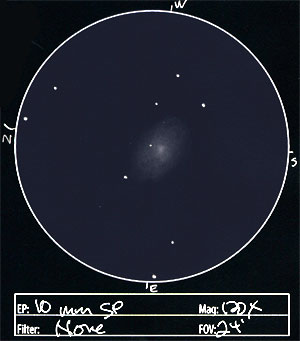
Observation Notes:
 I didn't pick up a lot of detail in this galaxy. It displayed an elliptical shape with a strongly condensed core that almost looked double in nature, due to an overlapping foreground star. The galaxy was elongated west-southwest to east-northeast, with a core that seemed to push northwest to southeast. I estimated its dimensions at 2.5' x 4'.
I didn't pick up a lot of detail in this galaxy. It displayed an elliptical shape with a strongly condensed core that almost looked double in nature, due to an overlapping foreground star. The galaxy was elongated west-southwest to east-northeast, with a core that seemed to push northwest to southeast. I estimated its dimensions at 2.5' x 4'.
Factoids
M109 is a barred spiral that displays a shape reminiscent of the Greek letter Theta. It is about 55 million light years away and receding at 1,142 km/sec. It is a member of the Ursa Major Cloud. It was discovered by Pierre Méchain in 1781. Charles Messier listed it under number 99 in a preliminary manuscript, but it was not added to the official catalog until 1953 when Owen Gingerich added it.
| Subject | M109 (NGC 3992) | |
| Classification | Spiral Galaxy (Type SBb I) | |
| Position* | Ursa Major [RA: 11:57:36 / Dec: +53:23:28] | |
| Size* | 7.6' x 4.9' | |
| Brightness* | 9.8 vMag. / 10.6 bMag / 13.4 Surface Brightness | |
| Date/Time | February 25, 2006 - 03:30 AM (February 25, 2005 - 10:30 UT) | |
| Observing Loc. | Anderson Mesa, AZ | |
| Instrument | Orion SVP 6LT Reflector (150 mm dia./1200 mm F/L) | |
| Eyepieces/Mag. | 10 mm (120X) | |
| Conditions | Clear, calm, 18°F | |
| Seeing | 3-4/10 | |
| Transparency | Mag 6.8 NELM | |
| *Sources | Orion's The Sky Software NGC/IC Project SEDS |
*Based on published data.




